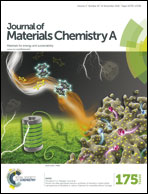Enhanced ZT and attempts to chemically stabilize Cu2Se via Sn doping
Abstract
Cu2Se is a p-type semiconducting compound that possesses excellent thermoelectric properties but degrades at elevated temperatures under large currents, precluding it from applications in harvesting waste heat. In this study, we make use of a doping approach to attempt to chemically stabilize Cu2Se while maintaining its superior thermoelectric properties. Specifically, we synthesized Cu2(1−x)SnxSe (x = 0, 0.01, 0.02 and 0.05) via melting, annealing and spark plasma sintering. We found that the ZT was enhanced the most in the x = 0.01 sample, averaging approximately a 15% increase over the pure Cu2Se throughout a broad temperature range of 473–823 K, and achieving a maximum ZT = 1 at T = 823 K. The enhancement is due to an increased power factor and a reduced thermal conductivity, which is a result of point defect scattering from Sn atoms in the Cu2Se matrix and grain boundary scattering from a micron-size secondary phase of SnSe. We further tested the ability of the Sn dopant to prevent material degradation at elevated temperatures under large currents. Increasing the Sn dopant content does indeed decrease the solid Cu precipitation but not enough to resolve the issue of material degradation. As a result, despite its improved ZT, Cu1.98Sn0.01Se is not yet ready for thermoelectric applications, and requires further effort to stabilize the structure.



 Please wait while we load your content...
Please wait while we load your content...